
Eduard Charlemont Giclée Fine Art Prints
1848-1906
Austrian Academic Classicism Painter
Eduard Charlemont, born in Vienna in 1848, is a figure whose artistic life seems woven into the fabric of Europe’s cultural capitals. Vienna, Paris, Rome – each city left its mark on his work, and Charlemont, in turn, left his imprint on the art world of the late 19th century. Coming from a family of artists, Charlemont was practically destined for the canvas. His father, Matthias, painted miniature portraits; his brother Hugo would go on to become an acclaimed Impressionist painter. Yet, Eduard’s talents quickly distinguished him. By 15, he was exhibiting at the Academy of Fine Arts in Vienna and even teaching drawing, an early sign of his precocity and dedication.
Charlemont’s art matured alongside his travels. He absorbed influences from Italy, Germany, and, most significantly, Paris, where he spent three decades. Paris in the late 19th century was not merely a place to paint; it was a crucible of modernity, a place where new ideas and techniques were constantly being forged. For Charlemont, it became both a proving ground and a stage. He won several first prizes at the Paris Salon, a prestigious achievement that cemented his reputation as one of the most skilled genre painters of his time. His works often evoke the elegance of 17th-century Flemish masters, particularly in his technical precision and attention to texture and light.
Yet Charlemont’s work was not limited to easel paintings. His talent extended to monumental murals, and he played a key role in the decoration of the Burgtheater in Vienna, working alongside artists like the Klimt brothers and his own brother Hugo. The Burgtheater murals, spanning a massive 55 meters, showcased his skill in narrative and composition, merging history with a theatrical sense of drama. These murals were part of a grand cultural project, emblematic of Vienna’s standing as a hub of European art and intellect. It was a space where Charlemont could combine storytelling and grandeur, infusing his scenes with vitality.
But it is "The Moorish Chief" that remains Charlemont’s most iconic work. Originally titled "The Guardian of the Seraglio", this 1878 painting depicts a Moorish swordsman standing guard in rich, flowing robes. There’s something magnetic about the figure – both exotic and deeply human. The painting, which now hangs in the Philadelphia Museum of Art, continues to captivate viewers, with its dramatic light, exquisite detail, and quiet sense of authority.
Charlemont's career is marked by a deep engagement with the classical traditions of Europe, combined with an impressive ability to distill the essence of character in both his portraits and genre scenes. He straddled two worlds: the old-world elegance of 17th-century genre painting and the burgeoning modernity of his own time. His work remains a compelling reminder of an era when painting was not just about representation but about capturing the complexities of life - its richness, its textures, and its fleeting moments. He died in 1906, but his art endures, quietly captivating, just as it did during his lifetime.
Charlemont’s art matured alongside his travels. He absorbed influences from Italy, Germany, and, most significantly, Paris, where he spent three decades. Paris in the late 19th century was not merely a place to paint; it was a crucible of modernity, a place where new ideas and techniques were constantly being forged. For Charlemont, it became both a proving ground and a stage. He won several first prizes at the Paris Salon, a prestigious achievement that cemented his reputation as one of the most skilled genre painters of his time. His works often evoke the elegance of 17th-century Flemish masters, particularly in his technical precision and attention to texture and light.
Yet Charlemont’s work was not limited to easel paintings. His talent extended to monumental murals, and he played a key role in the decoration of the Burgtheater in Vienna, working alongside artists like the Klimt brothers and his own brother Hugo. The Burgtheater murals, spanning a massive 55 meters, showcased his skill in narrative and composition, merging history with a theatrical sense of drama. These murals were part of a grand cultural project, emblematic of Vienna’s standing as a hub of European art and intellect. It was a space where Charlemont could combine storytelling and grandeur, infusing his scenes with vitality.
But it is "The Moorish Chief" that remains Charlemont’s most iconic work. Originally titled "The Guardian of the Seraglio", this 1878 painting depicts a Moorish swordsman standing guard in rich, flowing robes. There’s something magnetic about the figure – both exotic and deeply human. The painting, which now hangs in the Philadelphia Museum of Art, continues to captivate viewers, with its dramatic light, exquisite detail, and quiet sense of authority.
Charlemont's career is marked by a deep engagement with the classical traditions of Europe, combined with an impressive ability to distill the essence of character in both his portraits and genre scenes. He straddled two worlds: the old-world elegance of 17th-century genre painting and the burgeoning modernity of his own time. His work remains a compelling reminder of an era when painting was not just about representation but about capturing the complexities of life - its richness, its textures, and its fleeting moments. He died in 1906, but his art endures, quietly captivating, just as it did during his lifetime.
5 Eduard Charlemont Artworks
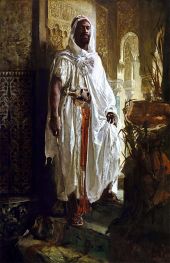
Giclée Canvas Print
$61.71
$61.71
SKU: 13418-CHE
Eduard Charlemont
Original Size:150.2 x 97.8 cm
Philadelphia Museum of Art, Pennsylvania, USA
Eduard Charlemont
Original Size:150.2 x 97.8 cm
Philadelphia Museum of Art, Pennsylvania, USA
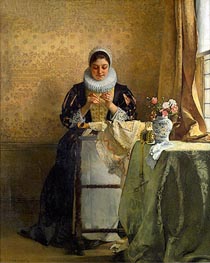
Giclée Canvas Print
$74.65
$74.65
SKU: 13421-CHE
Eduard Charlemont
Original Size:99.8 x 81.3 cm
Private Collection
Eduard Charlemont
Original Size:99.8 x 81.3 cm
Private Collection
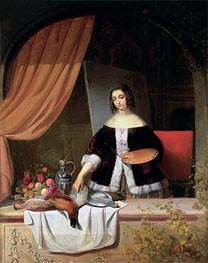
Giclée Canvas Print
$63.63
$63.63
SKU: 13419-CHE
Eduard Charlemont
Original Size:49 x 42 cm
Private Collection
Eduard Charlemont
Original Size:49 x 42 cm
Private Collection
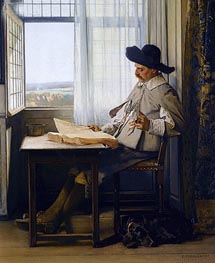
Giclée Canvas Print
$76.35
$76.35
SKU: 13422-CHE
Eduard Charlemont
Original Size:57 x 47.5 cm
Private Collection
Eduard Charlemont
Original Size:57 x 47.5 cm
Private Collection
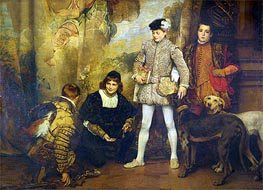
Giclée Canvas Print
$67.51
$67.51
SKU: 13420-CHE
Eduard Charlemont
Original Size:190.5 x 279.4 cm
Private Collection
Eduard Charlemont
Original Size:190.5 x 279.4 cm
Private Collection